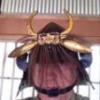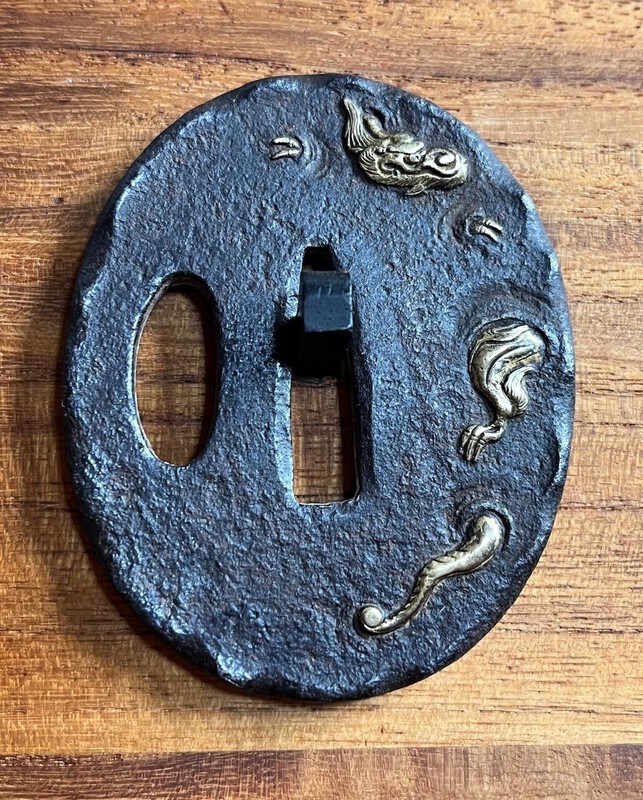-
Posts
14,079 -
Joined
-
Last visited
-
Days Won
260
Content Type
Profiles
Forums
Events
Store
Downloads
Gallery
Everything posted by Bugyotsuji
-

I accidentally bought a boys Tachi.
Bugyotsuji replied to Ben123's topic in General Nihonto Related Discussion
Is the blade signed? They can be worth a lot, but usual ground rules apply. Is it a genuine Chigo-to, or a toy? -
One extra comment. The quality and tight consistency of the material of the initial tsuba in this thread has the same feeling to me as the Shinchu lockwork on many Tanegashima matchlocks. Such shinchu was highly valued at the time.
-

Netsuke-like object name and material help needed
Bugyotsuji replied to John C's topic in Other Japanese Arts
Wow, that’s just nuts! (The working process on your thimble container looks very similar, but I’ve worked with tagua in the past and it’s not giving me the same material vibe as in John’s photos.) -
Concerning the difference between Ōdō 黄銅 and Shinchū 真鍮, an artisan friend in Osafune commented that my tsuba was Ōdō. (Posted once before, but pic follows) The difference lies in the metals forming the alloy with copper. https://study-z.net/100190152
-

Netsuke-like object name and material help needed
Bugyotsuji replied to John C's topic in Other Japanese Arts
Colin, I have a tagua pomander at home, (and a couple of tagua Netsuke) but the colour looks wrong. Tagua (vegetable ivory) starts white but gradually turns cloudy to dark orange. And the finished size and shape is limited by the size of the nut, unless you can find a giant one. -
US dollars? Wakizashi, Echizen, from Seki, C. 延宝 1673-81, with NTHK papers, you didn't pay too much.
-
Very punny, Mauro! The Japanese seem to love this kind of double-entendre. The cry 勝負 Shobu, "victory or death!" is also conjured up by 菖蒲 shobu, iris leaves.
-

Netsuke-like object name and material help needed
Bugyotsuji replied to John C's topic in Other Japanese Arts
Hi John. Thanks for posing a good question. I have seen these before but never really stopped to think too deeply about them. The way they are constructed reminds me of lathe and drill work of Victorian times, especially pomanders and some chess pieces. The shape is a hyotan (gourd), and the way the string is attached round the waist of the hourglass shape is one of the exceptions we find in Netsuke which more often than not attach through himotoshi holes. These hyotan Netsuke were made of various materials. I still have one in ivory, one in Edo 'bidoro' glass and another made of pine wood, though a rather attractive brass version managed to escape. From the sharp edging of the screw, my feeling is that it is a pomander that has been brought into service as a Netsuke, but I would not like to try and pin down where it was made. I have an ojime somewhere created in the same way. The material is another question. The base looks to be a separate piece that has been screwed or glued in place to cap off the bottom hole. Is there a corresponding piece at the top? Could it be whale bone? -

Yari spear Edo period info
Bugyotsuji replied to samurai7202's topic in General Nihonto Related Discussion
By the way, 三角 'Sankaku' means three facets, (triangle cross-section). You can find this kind of yari blade with equilateral facets, or isosceles, i.e. one larger flat side. -

Yari spear Edo period info
Bugyotsuji replied to samurai7202's topic in General Nihonto Related Discussion
Just one possibility, Roman, even if others laugh hysterically, so here goes. Many smiths moved to northwest Kyūshū in the 1590s to make spears for the military units gathering there for the Korean invasions. Since Christian symbolism was outlawed, one way of adding talismanic power plus ‘deniability’ was by incorporating a 十 cross into what looks like a production number with 十 ten in it. I have a Kumamoto Castle Hosokawa gun for example, covered in numbers, but each series seems to contain at least one 10, …and we know the Hosokawa were Christians, even if not openly. Just a romantic theory for the pot, Roman, but we love the romance of these things! -

Bought Tsuba at Tokyo flea market. Looking for information on it!
Bugyotsuji replied to dgut's topic in Tosogu
What I honestly think is that even where it is ‘wrong’ in some detail, it gives you a hell of a lot of background information, plus a warm fuzzy feeling, as if that world is close and familiar. It also encourages further study in a positive way. -

Another Case Of Damage From Being Shipped In A “Tsuba Box”
Bugyotsuji replied to Xander Chia's topic in Tosogu
Nice tsuba ! (There seem to be other, older dings and scratches from before, so maybe things can be toned down somewhat.) -

Another Case Of Damage From Being Shipped In A “Tsuba Box”
Bugyotsuji replied to Xander Chia's topic in Tosogu
Been there, done that, and it’s the worst feeling. (At least you are not blaming yourself though.) Feel for you! Lesson to us all to request careful packaging, in advance of shipment. -

Bought Tsuba at Tokyo flea market. Looking for information on it!
Bugyotsuji replied to dgut's topic in Tosogu
Yes, but not yet all of it perfectly. (Most unusual to have the story down the mimi sides.) -
Good job! No-one would spot that, I bet. Nice invisible rivets too! We only know your secret because you have told us!
-
Well Jean, now you have poised two or three very good questions. A couple of years back I translated some research done on Japanese armo(u)r. A line in a written record from about 1570 caught my eye, where the writer mentions visiting an armor workshop where the overwhelming impression was workers drilling holes in metal. As I recall, it specifically mentioned them working with 錐 ‘Kiri’, which is not a punch. If anyone knows more detail about this, I too would be interested to learn. So… Q.1. Were the holes in armor plates drilled or punched?
-
Drilling in iron went back, way back to the beginnings of Japan time, for kabuto ‘hoshi’ rivets. Some armorers, as we know, produced tsuba too, and some went on to specialize in them. I am imagining a time when hand- or foot-driven drilling technique moved for whatever reason over into the tsuba world. And Nakago were of even thicker iron, closer to tsuba thickness. ‘Random’ may be overstating it, but playful it certainly must have been, from the imagination through the planning into the execution. Some of the examples above allow your brain to flip-flop flash between positive and negative sukashi, in a “Now you see it, now you don’t” cameo.
-
Not wishing to prove controversial, with added apologies for the side-stepping, but here is an example of a Netsuke demonstrating (in my opinion) the use of a drill to create a pattern or design. Was there a period when this kind of work was fashionable, I wonder, in which the actual meaning of the design was incidental or even secondary?
-
I have found two or three artisans who signed Joryū, but the sole book I rely on here does not mention the name Masanao. Any luck your end?
-
如柳正直 Joryū Masanao (Alternative reading Nyoryū?)
-
Still have not reached the Chinese New Year, so allow me to add an iron Tantō/wakizashi tsuba with a golden dragon weaving through the clouds. The rust looked active, so today I finally sat down to clean it up. First time I have given this tsuba a serious look, as it was just kicking its heels in the odd tsuba box. and the other side of the cloud…
-
-
-
Hmmm… if not, try Seki, Kanesada. 関 兼定










